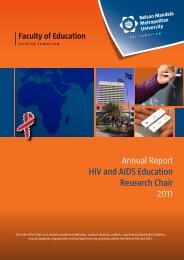USING A DIFFERENT LENS FOR HIV and AIDS EDUCATION ...
USING A DIFFERENT LENS FOR HIV and AIDS EDUCATION ...
USING A DIFFERENT LENS FOR HIV and AIDS EDUCATION ...
Create successful ePaper yourself
Turn your PDF publications into a flip-book with our unique Google optimized e-Paper software.
Other points<br />
Ask permission to take pictures in public places such as shops.<br />
Ensure the safety <strong>and</strong> security of young photographers who may be more vulnerable<br />
because they have cameras. As the adult in a project, try to accompany the<br />
photographers as much as possible.<br />
Be sensitive (<strong>and</strong> teach sensitivity) to local contexts. Sometimes it is not appropriate<br />
to take photographs or make videos in public places.<br />
Discussion<br />
Not all pictures without people in them are necessarily anonymous. An item of<br />
clothing or a bruise on an arm, for example, may be very revealing. This is why it is<br />
important to spend time discussing visual ethics in relation to specific images. In that<br />
way participants will get a better idea that issues of ethics are grey <strong>and</strong> not always<br />
„black <strong>and</strong> white‟.<br />
Some guiding questions:<br />
� Is this photograph revealing of someone? Why or why not?<br />
� What could you do to make a picture less revealing?<br />
� How does visual ethics link to teaching about human rights?<br />
52



